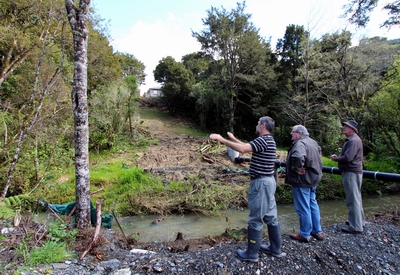$8.6M Kotuku detention dam project to begin in earnest
22 Aug 2014, 10:15 AM
Construction on a massive stormwater detention dam designed to better protect Whangarei’s central business district from damaging floods will be underway in earnest within weeks.
 Northland Regional Councillors Craig Brown, centre, and John Bain, right, are briefed in Raumanga on the footprint of the proposed Kotuku detention dam by council Rivers Programme Manager Joseph Camuso, left. Councillor Brown chairs the Urban Whangarei Rivers Liaison Committee, while Cr Bain is one of two councillors who represent the Urban Whangarei constituency the dam will be sited in.
Northland Regional Councillors Craig Brown, centre, and John Bain, right, are briefed in Raumanga on the footprint of the proposed Kotuku detention dam by council Rivers Programme Manager Joseph Camuso, left. Councillor Brown chairs the Urban Whangarei Rivers Liaison Committee, while Cr Bain is one of two councillors who represent the Urban Whangarei constituency the dam will be sited in.
Northland Regional Council member Craig Brown who chairs the Urban Whangarei Rivers Liaison Committee, says the council had recently purchased the final property it needed and roughly $2.7M of work to build the dam itself is now scheduled to begin in October.
Councillor Brown says of the estimated $8.6M (GST excl) final cost of the Kotuku detention dam project, about $5 million would have been spent securing the 20 properties needed, with another several hundred thousand dollars to relocate power and other utilities in recent months. The remainder would pay for the dam itself and some associated final landscaping.
He says the contract to build the dam itself – to sit at the ends of Raumanga Valley Road in Raumanga and Kotuku Street, Maunu – has gone to MAP Projects Ltd, which aims to have it finished in autumn next year.
Councillor Brown says MAP is an experienced Rotorua-based civil contracting business that has successfully completed a number of challenging civil construction projects in recent years, including several hydro civil works and dam works and the tender had been awarded after a robust and keenly-contested process.
"This is one of the largest engineering projects the regional council has undertaken and when finished, the 18-metre high dam will hold up to 1.27 million cubic metres of floodwater during heavy rain, about two-thirds the capacity of the existing Whau Valley dam."
However, Cr Brown says unlike the Whau Valley dam, which provides drinking water to much of urban Whangarei, the Kotuku dam is designed to trap vast amounts of water and then slowly release it over several days.
He says much of the damage caused by floods depends not only on how deep they are, but importantly, also how fast they are travelling.
"In layman's terms, the Kotuku dam will help address both of these, slowing floodwaters and also cutting flood depths in the CBD by up to half a metre."
Councillor Brown says the dam will be paid for via an existing targeted rate on more than 17,000 properties in the CBD and contributing catchment areas, but given it had the potential to reduce flood-related damage worth millions of dollars from a single flood, it would be money well-spent.
He says the targeted rate was established under the council's last Long Term Plan (LTP) in 2012 when the dam's cost was estimated at about $6.9M (excluding GST).
That figure had been firmed up to its current level based on completion of a more detailed dam design and peer review outcomes, resource consent requirements and given the costs of relocating utilities over the past few months and buying the land needed were now known.
Councillor Brown says the council expects to consult the public next year about changing its Whangarei Urban Rivers Management Rate to accommodate the revised cost as part of work on its new Long Term Plan for 2015-2025.
However, in the meantime, council will continue to work with the Urban Whangarei Rivers Liaison Committee, whose members include representatives from the Whangarei District Council, business and ratepayer communities and tangata whenua.
He says a site blessing is to be organised involving iwi, regional and district councillors will be held soon and among the first steps will be the demolition of five of eight houses that will eventually need to make way the dam, as well as the clearance of some bush. (The houses can't be relocated due to the way they are built so the first five will be demolished and the remaining three used to accommodate workers during the build and be demolished towards the end of it.)
"Demolition of those homes is due to begin at the start of next month, with the general contractor on site about mid-month and construction beginning in October."
Councillor Brown says information on the project will be posted on the regional council's website as the project progresses but says existing presentations and reports are already available via: www.nrc.govt.nz/kotukudam
